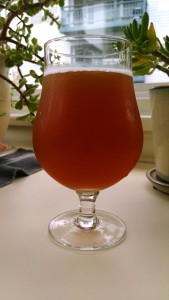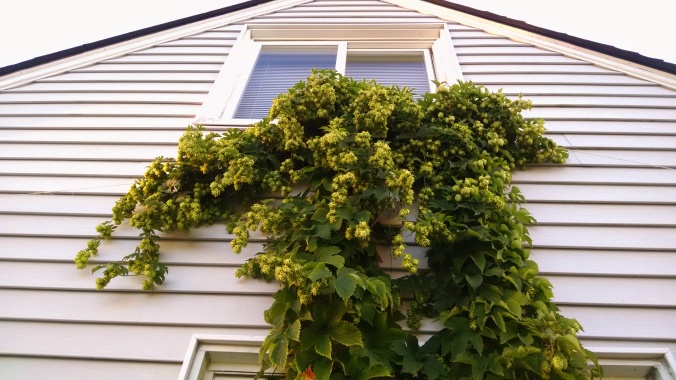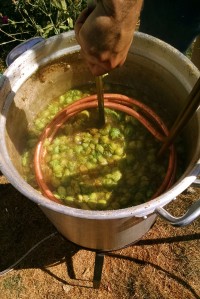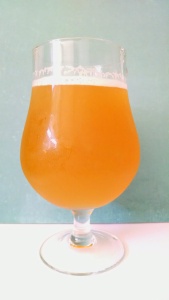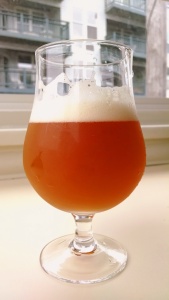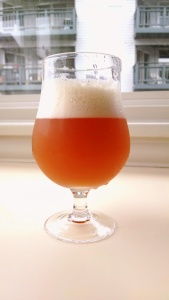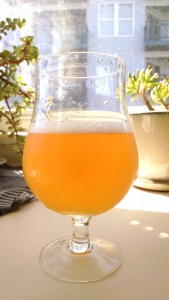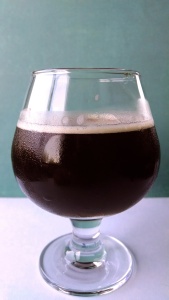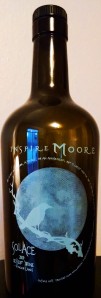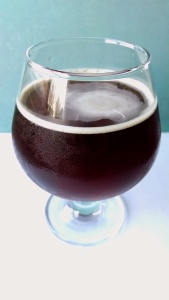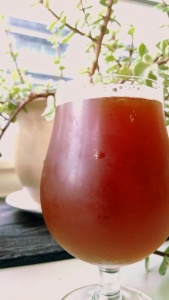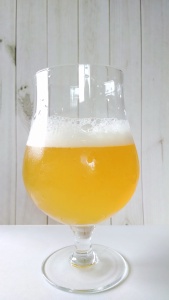 This post will detail two recent saisons that we brewed for and/or during spring here in the PNW. The first is a version of our pink peppercorn saison that we added wisteria and lilac flowers to and heavily hopped with Chinook (we had a bunch laying around and had to use them up). The second is a fir tip table saison we brewed using fir tips Gregory foraged in Leavenworth, WA.
This post will detail two recent saisons that we brewed for and/or during spring here in the PNW. The first is a version of our pink peppercorn saison that we added wisteria and lilac flowers to and heavily hopped with Chinook (we had a bunch laying around and had to use them up). The second is a fir tip table saison we brewed using fir tips Gregory foraged in Leavenworth, WA.
I’ve wanted to use lilac in a beer for a while now and figured it would marry well with the floral peppercorns and Chinook’s earthy-spicy notes. While Nate, a longtime friend of mine, was visiting I brought this up to him and he recalled that he had success using wisteria in a saison. In West Seattle both lilac and wisteria grow abundantly and were available early as we’ve had a very warm season, so I decided to use them both.
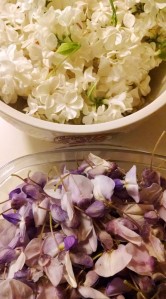 Gregory and I wanted to experiment with ester and phenol production as they relate to fermentation temperature with our go-to saison yeast — we usually use the brewbelt with Wyeast’s French Saison strain, which sometimes produces more bubblegum/banana notes than we desire — so we opted to let the yeast “free-rise.” We used the same grain bill as our previously brewed pink peppercorn petite saison, but got better mash efficiency and attenuation so we ended up with a higher ABV and a drier beer. The absence of the brewbelt almost eliminated the esters/phenols associated with saisons, resulting in a beer that is more akin to a pale ale than a saison.
Gregory and I wanted to experiment with ester and phenol production as they relate to fermentation temperature with our go-to saison yeast — we usually use the brewbelt with Wyeast’s French Saison strain, which sometimes produces more bubblegum/banana notes than we desire — so we opted to let the yeast “free-rise.” We used the same grain bill as our previously brewed pink peppercorn petite saison, but got better mash efficiency and attenuation so we ended up with a higher ABV and a drier beer. The absence of the brewbelt almost eliminated the esters/phenols associated with saisons, resulting in a beer that is more akin to a pale ale than a saison.
For the fir tip table saison, we wanted something very light, dry, and easy-drinking. We simplified both the grain bill and the hop additions, using classic European hop varietals. Knowing we usually get better efficiency/attenuation than what Brewtoad calculates for session beers, we crafted a recipe that they determined would only be about 2.9% ABV to arrive at our desired 3.5% ABV. We used White Labs’ Belgian Style Saison Blend and used the brewbelt for a shorter amount of time than we normally do (3 days as opposed to a week) to continue experimenting with ester/phenol production. We added the fir tips from Leavenworth twice in the boil.
Read on for recipes, processes, tasting notes, and additional photos:
Kitchen Sink Saison With Pink Peppercorn, Lilac, & Wisteria
Recipe Specifics
Batch Size (Gal): 5.5
Total Grain (Lbs): 8.00
Anticipated OG: 1.039
Anticipated SRM: 2.0
Anticipated IBU: 33
Brewhouse Efficiency: 75%
Wort Boil Time: 90 Minutes
Grain
50.00% — 4.00 Lbs. Pilsner (BE)
25.00% — 2.00 Lbs. Vienna
12.50% — 1.00 Lbs. Flaked Oats
12.50% — 1.00 Lbs. Wheat
Hops
0.30 oz. Magnum (Pellet, 13.0% AA) @ 60 min.
0.50 oz. Chinook (Pellet, 12.0% AA) @ 10 min.
0.50 oz. Horizon (Pellet, 12.0% AA) @ 10 min.
2.00 oz. Chinook (Pellet, 12.0% AA) @ 01 min.
0.80 oz. Saaz (Pellet, 3.2% AA) @ 0 min.
2.00 oz. Chinook (Pellet, 12.0% AA) @ 4 days (dry hop)
2.00 oz. Chinook (Pellet, 12.0% AA) @ 7 days (dry hop)
Extras
1.00 tsp Yeast Nutrient @ 10 min.
1.00 Whirlfloc @ 15 min.
7.0g Pink Peppercorns (ground) @ 5 min.
1.60 oz. Fresh Lilac Flowers @ 5 days (in keg)
3.15 oz. Fresh Wisteria Flowers @ 5 days (in keg)
Yeast
Wyeast 3711 — French Saison
Water Profile
Seattle
1.00 g Calcium Chloride
1.50g Gypsum
Mash Schedule
Single infusion – 60 min @ 155F
Mash out — 10 min @ 172F
Notes
03.31.16 — Made a starter of French Saison
Brewed on 04.12.16 with Gregory
04.12.16 — Chilled wort to 77F & pitched the yeast
04.14.16 — Vigorous fermentation activity
04.16.16 — Added half of the dry hops to primary as fermentation slows
04.20.16 — Transferred to secondary and added remaining dry hop additions
04.27.16 — Split the batch and bottled two gallons with 2 oz. corn sugar for 2.6 volumes CO2, and kegged the remaining three gallons, adding the flowers in the keg for 5 days before removing them.
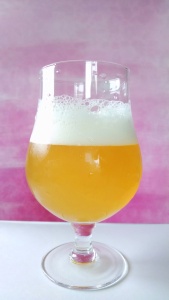 Tasting Notes — 06.08.16 (poured off tap)
Tasting Notes — 06.08.16 (poured off tap)
Yellow-straw color and clear with a large fluffy white head stand that dissipates slowly and laces thick. Big floral notes and a hint of peppercorn on the nose. Hardly any saison esters/phenols detected. Body is very dry and crisp with the herbal, grassy and spicy notes of Chinook dominating the palate. Finishes with vivid and lingering earthy bitterness, and some peppercorn spice.
Calculated OG: 1.045
Calculated FG: 1.002
Approx. ABV: 5.6%
Fir Tip Table Saison
Recipe Specifics
Batch Size (Gal): 5.5
Total Grain (Lbs): 6.00
Anticipated OG: 1.030
Anticipated SRM: 1.0
Anticipated IBU: 22
Brewhouse Efficiency: 75%
Wort Boil Time: 90 Minutes
Grain
66.67% — 4.00 Lbs. Pilsner (BE)
16.67% — 1.00 Lbs. Flaked Oats
16.67% — 1.00 Lbs. Wheat
Hops
0.75 oz. East Kent Goldings (Pellet, 5.7% AA) @ 60 min.
1.00 oz. East Kent Goldings (Pellet, 5.7% AA) @ 5 min.
1.00 oz. East Kent Goldings (Pellet, 5.7% AA) @ 1 min.
Extras
1.00 tsp Yeast Nutrient @ 10 min.
1.00 Whirlfloc @ 15 min.
1.80 oz. Fir Tips @ 5 min.
1.80 oz. Fir Tips @ 1 min.
Yeast
White Labs WLP568 — Belgian Style Saison Yeast Blend
Water Profile
Seattle
1.00 g Calcium Chloride
1.50g Gypsum
Mash Schedule
Single infusion – 70 min @ 154F
Mash out — 10 min @ 172F
Notes
Brewed on 05.12.16 with Gregory
05.12.16 — Chilled wort to 70F, pitched the yeast & put onto brewbelt
05.14.16 — Vigorous fermentation activity
05.15.16 — Removed brewbelt
05.22.16 — After 10 day primary, kegged the batch and began force carbonating
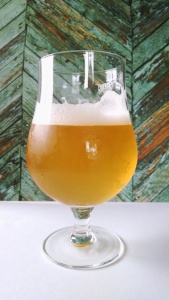 Tasting Notes — 06.08.16 (poured off tap)
Tasting Notes — 06.08.16 (poured off tap)
Pale-straw color with large fluffy white head stand that dissipates quickly and laces medium. Light grainy pils malt and a hint of bubblegum on the nose. Citrus and pine form the fir is mellow but center stage on the palate. Light and creamy mouthfeel with a round and smooth bitter flourish on the dry finish.
Calculated OG: 1.030
Calculated FG: 1.004
Approx. ABV: 3.4%
 This is a pretty straight forward, Azacca heavy, hoppy pale that I added foraged spruce tips to post-boil. The hops schedule resembles those of my recent “juice”, or New England, or hazy pales/IPAs, but the grain bill forgoes the flaked grain adjuncts. As with most of my recent quick turn-around beers, this brew underwent dry hopping (and in this case the addition of the spruce tips) in primary. I then cold crashed the beer in a chest freezer before kegging.
This is a pretty straight forward, Azacca heavy, hoppy pale that I added foraged spruce tips to post-boil. The hops schedule resembles those of my recent “juice”, or New England, or hazy pales/IPAs, but the grain bill forgoes the flaked grain adjuncts. As with most of my recent quick turn-around beers, this brew underwent dry hopping (and in this case the addition of the spruce tips) in primary. I then cold crashed the beer in a chest freezer before kegging. Tasting Notes — 10.01.18 (on draft)
Tasting Notes — 10.01.18 (on draft)


